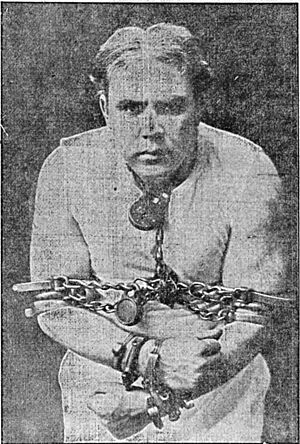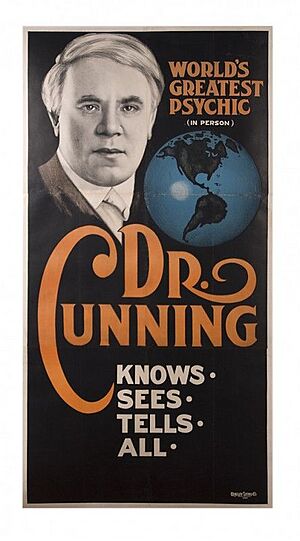Doc Cunningham facts for kids
Robert Marion "Doc" Cunningham (1873–1951) was a famous American illusionist, stunt performer, and showman. He used many exciting stage names. Some of these included Zante, Cunning the Jail Breaker, Cunning the Handcuff King, Doc Cunning, The Mental Miracle Man, and Cunning the Supermind. He amazed audiences with his magic and daring escapes.
Contents
Robert "Doc" Cunningham: Master of Magic and Escapes
Early Days as Zante: A Magician's Journey
Robert (Bob) Marion "Doc" Cunningham was born in Provo, Utah, on April 12, 1873. He started performing magic shows as "Zante." He might have been inspired by another famous Utah magician, Oscar Eliason, known as Dante the Great. By late 1899, Cunningham had toured Montana, Idaho, and California. People began comparing him to Eliason, who had recently passed away unexpectedly during a successful tour in Australia. Cunningham even performed a daring trick involving bullets, which was one of Eliason's famous acts.
On his first tour outside North America, Cunningham showed respect for Eliason. He visited Eliason's grave and met his widow, Edmunda, in Sydney in April 1902. In Australia, advertisements called Cunningham "America's greatest and most popular magician." He performed with a group of talented American vaudeville artists. However, Cunningham started his Australian tour in New South Wales at a challenging time. Oscar Eliason's younger brother, Frank, was also touring the same state as "Dante the Marvellous." Frank Eliason was very popular, performing for large crowds.
After less than a month, Cunningham moved to New Zealand. He felt that show business in Australia was "especially slack." In New Zealand, he was again promoted as "America's greatest magician." He focused on amazing sleight-of-hand tricks. He toured New Zealand for most of 1902 and earned much praise.
The Handcuff King: Daring Escape Stunts
Soon after returning to the U.S. from his tour, Cunningham changed his act. For almost ten years, he focused on incredible escape stunts. He called himself "Cunning the Jail Breaker" or "Cunning the Handcuff King." His interest in escape acts began when he was a boy. He saw a hole in the wall of the local jail in Provo. This sight sparked his imagination about how people could get free.
Many times during his U.S. tours in the early 1900s, he challenged local police. He asked them to use their strongest handcuffs and devices to secure him. Then, he would amaze them by setting himself free. This publicity helped sell tickets for his stage shows. In his act, he would free himself after being chained and handcuffed inside a locked steel cage. Audience members, often police officers, carefully checked all the locks and restraints.
By early 1905, some people saw Cunningham as a rival to the famous Harry Houdini (1874-1926). In one event in Harlem in May 1905, Houdini's older brother, William Weiss, challenged Cunningham. He handed Cunningham handcuffs and dared him to put them on and take them off in seven minutes. Cunningham struggled and said the handcuffs were "fixed." A disagreement followed, which led to a brief problem with the police. One of Cunningham's managers, J. M. Howard, later remembered "a great deal of professional rivalry" between Cunningham and Houdini. He said, "If either used a new publicity stunt, the other would soon adopt it." However, Cunningham did not have the diving and swimming skills to match Houdini's underwater escapes. For several months in 1907, Cunningham toured in a play called "From Sing Sing to Liberty." His handcuff work was a main part of the show. In 1908, he toured Mexico, still performing escape acts and sleight-of-hand tricks.
Mind-Reading Marvel: From Escapes to Mentalism
While still doing escape acts, Cunningham began to change his shows around 1909. He started focusing on mentalism, which involves mind-reading and other mental feats. It seems he got many new ideas from Oscar Eliason's widow, Edmunda. Between 1909 and 1912, Cunningham's main assistant was "Mademoiselle Edmunda." This was the same name Eliason's wife used when she performed with him. His new assistant was called the "psychic wonder of the world."
New acts soon became a big part of Cunningham's show. These acts were similar to those performed by Eliason or his widow. They included making his assistant's body float horizontally in the air. He also showed demonstrations of supposed "mind reading" and other mental powers. After working with "Mademoiselle Edmunda," Cunningham went back to escape acts for a while. But by 1916, he returned to mentalism. He appeared on the same programs as Claude Alexander Conlin (1880-1954), a well-known mentalist called Alexander the Man Who Knows. Cunningham performed a separate act, creating "spirit pictures."
He then competed with Alexander on tours across the U.S. and Canada. He often used Alexander's catchphrase, "Man Who Knows," in his ads. Like Alexander, a "Simla Séance" became part of his show. He also invited questions from the audience. He then used his supposed mental powers to answer them. For a time, Cunningham still performed sleight-of-hand tricks and illusions. But by 1920, he no longer did escape tricks. He called himself "The Mental Miracle Man" and "The Man Who Knows." His advertisements suggested he could communicate with unseen forces and "actually look into the future." He also answered personal questions about life's puzzles. By 1922, he promoted himself as Dr Cunning. His entire show was about his supposed psychic abilities. This show continued until late 1923.
Life Under the Big Top: A Circus Showman
From 1924 to 1926, "Doc" Cunningham worked for the Al G. Barnes Circus. This was a big show that toured across the U.S. for most of the year. Cunningham managed the circus's side-show and annex. He was also an announcer under the big-top in the main show. Cunningham later used his circus experience to get other related jobs. For example, in 1934, he was the announcer at a July 4th fireworks show and circus in Los Angeles.
Later Years: Santa Claus and Magic's Legacy
Cunningham was always willing to try new things in his career. After he stopped touring and settled in California in the mid-1930s, he ran a miniature dog and pony show. He performed at schools, community fairs, and shopping centers. During Christmas, he worked as a professional Santa Claus. His friend and fellow magician, Frank Herman, worked with him in 1939. Herman said Cunningham convinced children he was the real Santa. He did this by using information sent to him through earphones hidden under his cap and wig. A "Princess" would talk to the children as they signed in and then relay the information to Santa.
Cunningham spent most of his career in the world of magic. He earned great respect from other magicians. The magazine Genii reported in October 1944 that he had suffered a stroke. They wrote, "Doc is one of magic's greatest characters." A few months later, the Los Angeles Society of Magicians held a special dinner for Cunningham. About 200 people attended, including some of the top performers in the U.S.
Family Life of a Famous Magician
Cunningham married Alice "Allie" Eva Dunn in Provo on September 21, 1892. At first, she traveled with him on tour. But as their family grew, it became difficult for her to continue. Robert Cunningham passed away in Los Angeles in March 1951, at the age of 71. He was survived by his wife, Alice, two sons, two daughters, 12 grandchildren, and 15 great-grandchildren.



